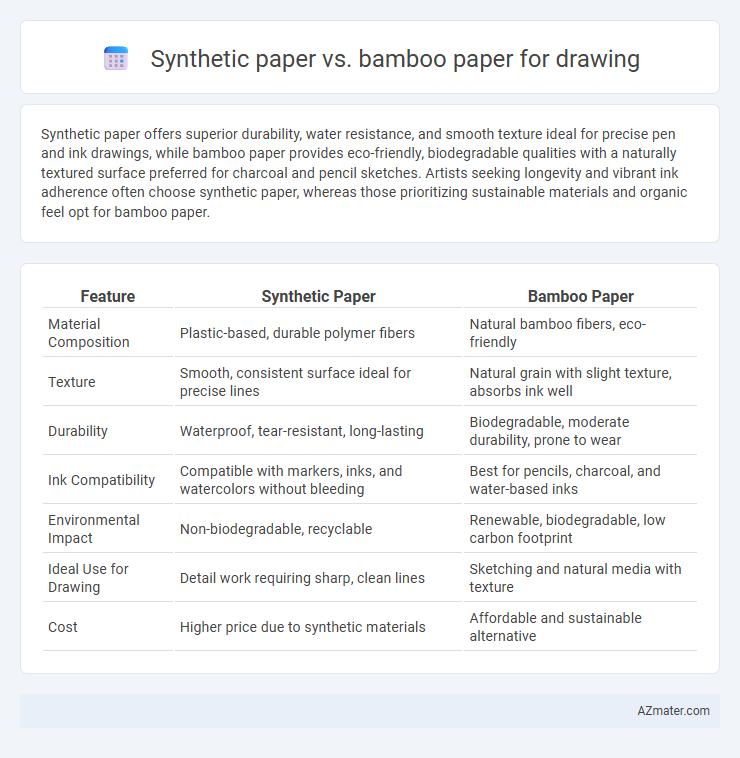Synthetic paper offers superior durability, water resistance, and smooth texture ideal for precise pen and ink drawings, while bamboo paper provides eco-friendly, biodegradable qualities with a naturally textured surface preferred for charcoal and pencil sketches. Artists seeking longevity and vibrant ink adherence often choose synthetic paper, whereas those prioritizing sustainable materials and organic feel opt for bamboo paper.
Table of Comparison
| Feature | Synthetic Paper | Bamboo Paper |
|---|---|---|
| Material Composition | Plastic-based, durable polymer fibers | Natural bamboo fibers, eco-friendly |
| Texture | Smooth, consistent surface ideal for precise lines | Natural grain with slight texture, absorbs ink well |
| Durability | Waterproof, tear-resistant, long-lasting | Biodegradable, moderate durability, prone to wear |
| Ink Compatibility | Compatible with markers, inks, and watercolors without bleeding | Best for pencils, charcoal, and water-based inks |
| Environmental Impact | Non-biodegradable, recyclable | Renewable, biodegradable, low carbon footprint |
| Ideal Use for Drawing | Detail work requiring sharp, clean lines | Sketching and natural media with texture |
| Cost | Higher price due to synthetic materials | Affordable and sustainable alternative |
Introduction to Synthetic Paper and Bamboo Paper
Synthetic paper, made from plastic polymers like polypropylene, offers exceptional durability, water resistance, and smooth texture ideal for detailed drawing and ink work. Bamboo paper, produced from sustainable bamboo fibers, provides a natural, eco-friendly alternative with a soft texture that enhances charcoal and pencil sketches. Both materials cater to different artistic needs, balancing durability and environmental impact for diverse drawing applications.
Material Composition and Sustainability
Synthetic paper is composed mainly of polypropylene, offering tear resistance and water-proof properties ideal for detailed, durable artwork. Bamboo paper, derived from fast-growing bamboo fibers, provides a natural, biodegradable alternative with a lower environmental impact due to its rapid renewability and carbon sequestration during growth. Bamboo paper excels in sustainability metrics, while synthetic paper prioritizes longevity and physical resilience for professional drawing applications.
Texture and Surface Quality Comparison
Synthetic paper offers a smooth, waterproof texture that resists bleeding and smudging, ideal for ink and marker drawings requiring crisp, clean lines. Bamboo paper features a natural, slightly coarse surface that enhances grip for pencil and charcoal, providing a traditional, tactile drawing experience with excellent texture variation. Surface quality on synthetic paper ensures durability and uniformity, while bamboo paper's organic fibers create unique textures that influence shading and blending techniques.
Absorbency and Ink Compatibility
Synthetic paper offers superior ink compatibility due to its plastic-based surface that resists bleeding and feathering, making it ideal for precise, detailed drawing with markers, pens, and inks. Bamboo paper, being more porous and natural, has higher absorbency, which can cause inks to spread and blend, suitable for watercolor and brush techniques but less effective for sharp lines. Choosing between synthetic and bamboo paper depends on the desired ink behavior, with synthetic paper favoring crisp, controlled ink application and bamboo paper enabling soft, diffused effects.
Durability and Resistance to Wear
Synthetic paper offers exceptional durability and resistance to wear, making it ideal for drawing projects that require long-lasting, tear-resistant surfaces. Bamboo paper, while eco-friendly and with a natural texture favored by artists, is generally less resistant to moisture and abrasion, resulting in faster degradation under heavy use. For artists prioritizing longevity and resilience, synthetic paper outperforms bamboo paper in preserving the integrity of detailed drawings over time.
Environmental Impact and Eco-Friendliness
Synthetic paper, made from plastic resins like polypropylene, offers durability and water resistance but has a higher environmental footprint due to non-biodegradable materials and energy-intensive production processes. Bamboo paper, derived from fast-growing bamboo plants, is biodegradable, renewable, and requires fewer pesticides or fertilizers, making it a more eco-friendly option with a lower carbon footprint. Choosing bamboo paper for drawing supports sustainable forestry and reduces plastic waste, aligning better with environmentally conscious art practices.
Suitability for Different Drawing Mediums
Synthetic paper offers excellent compatibility with wet mediums such as markers, ink, and watercolor due to its water-resistant and non-absorbent surface, allowing vibrant colors and smooth blending without warping. Bamboo paper, made from natural fibers, excels with dry mediums like charcoal, pencil, and pastels, providing a textured surface that enhances grip and depth but may cause bleeding or feathering with wet applications. Artists seeking versatility often opt for synthetic paper when working with mixed media, while bamboo paper suits traditional dry medium techniques for a more organic finish.
Cost and Availability
Synthetic paper generally costs more than bamboo paper due to its specialized manufacturing processes and durability features. Bamboo paper is often more affordable and widely available, as it leverages sustainable bamboo resources and traditional paper production methods. Artists seeking budget-friendly options with eco-friendly credentials may prefer bamboo paper, while those requiring water resistance and tear strength might invest in synthetic paper despite its higher price.
User Experience and Artist Preferences
Synthetic paper offers a smooth, water-resistant surface that resists tearing and bleeding, making it ideal for mixed media artists who use markers, inks, and watercolors. Bamboo paper provides a natural texture with excellent absorbency and eco-friendly appeal, preferred by artists who value sustainability and a traditional drawing feel. User experience often hinges on the desired medium and finish, with synthetic paper favored for durability and vibrancy, while bamboo paper attracts those seeking organic texture and environmental benefits.
Final Thoughts: Which Drawing Paper is Best?
Synthetic paper offers superior durability, water resistance, and smooth texture, making it ideal for detailed ink and marker drawings. Bamboo paper provides a more eco-friendly option with a natural texture that enhances pencil and charcoal artwork, though it may be less resistant to wear and tear. For artists prioritizing longevity and precision, synthetic paper is the best choice, while bamboo paper suits those seeking sustainable materials and traditional drawing experiences.

Infographic: Synthetic paper vs Bamboo paper for Drawing
 azmater.com
azmater.com